Caldicot, Monmouthshire
Caldicot (Welsh: Cil-y-coed) is a town and community in Monmouthshire, southeast Wales, located between Chepstow and Newport on the Gloucester–Newport line served primarily by Caldicot station, whilst by road it is just off the busy M4 / M48 motorway corridor. The site adjoins the Caldicot Levels, on the north side of the Severn Estuary. Caldicot has easy access on the railway west to Newport, Cardiff Central and east to Chepstow, Lydney, and Gloucester, as well as one stop west to Severn Tunnel Junction and then east via the Severn Tunnel to Filton Abbeywood and Bristol Temple Meads and further afield. Generally good road access to Cardiff and across the Second Severn Crossing, old Severn Bridge to Bristol. The population of the town is around 11,000. It has a large school, Caldicot School, and is known for its medieval castle. The built-up area includes Portskewett. Caldicot had a population of 9,604 in 2011.[2]
Caldicot
| |
|---|---|
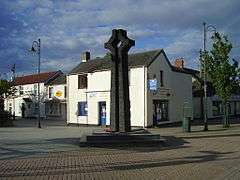 Caldicot Cross in the town centre, a memorial to the deaths of local soldiers in World War I, World War II and other conflicts. | |
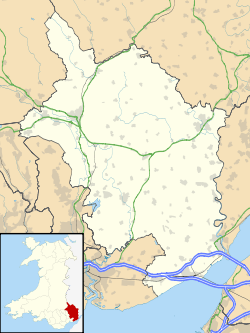 Caldicot Location within Monmouthshire | |
| Population | 11,424 (2014)[1] |
| OS grid reference | ST475885 |
| Principal area | |
| Ceremonial county | |
| Country | Wales |
| Sovereign state | United Kingdom |
| Post town | CALDICOT |
| Postcode district | NP26 |
| Dialling code | 01291 |
| Police | Gwent |
| Fire | South Wales |
| Ambulance | Welsh |
| UK Parliament | |
History
There was considerable activity in the area during the Bronze Age. Excavations near the Nedern Brook beside the castle revealed a plank from a boat and complex wooden structures in the former river bed. The boat probably traded across the Severn with the farmers and traders of Somerset. Later, in Roman times, it is likely that trading vessels sailed up the Nedern Brook to Caerwent. The discovery of kilns also shows that coarse pottery was produced in the village during Roman times.[3]
In 1074, following the Norman Conquest, the manor of Caldicot was given to Durand, the Sheriff of Gloucester. Caldicot is recorded in the Domesday Book in 1086. Its entry reads, Durand the Sheriff holds of the King, one land, in Caerwent, called Caldicot. He has in demesne there 3 ploughs, and 15 half villeins, and 4 bondmen, and one knight. All these have twelve ploughs. There is a mill worth ten shillings.
The name 'Caldicot' is usually stated to derive from the Old English phrase calde cot meaning 'cold hut'. A cold hut is an exposed shelter used by either humans or animals. The modern Welsh name, Cil-y-coed, meaning "corner of the wood", referring to Wentwood, is an example of folk etymology.[4]
One of the oldest buildings in Caldicot, Llanthony Secunda Manor, was built around 1120 as a grange for monks from Llanthony Secunda Priory in Gloucester.[5]
In 1158 the manor of Caldicot passed to Humphrey II de Bohun, who was responsible for building the stone keep and curtain walls of the present-day castle. In 1376 it passed to Thomas Woodstock, third son of King Edward III, when he married Alianore de Bohun. It began to fall into ruins around the 16th century.
Caldicot is one of the few villages to appear on the Cambriae Typus map of 1573.[6]
By the mid-19th century, Caldicot was a small farming village. However, the opening of the South Wales Railway brought London and Cardiff within relatively easy reach (although Caldicot station itself was not opened until 1936). The railway attracted industry, and 1862 Henry Hughes of Tintern opened a wireworks next to the railway, becoming the village's major employer and attracting many new workers. In 1880 it became a tinplate works for the canning industry. In 1879 work began on the Severn Tunnel, which was opened in 1886. Its construction brought hundreds of workers to Caldicot, roughly doubling its population.[3][7]
Court House was the home of baker Henry Jones, the inventor of self-raising flour, from 1864 until his death in 1891. He is buried in the churchyard.[8]
During the first half of the 20th century, Caldicot continued to grow steadily, but unspectacularly, reaching a population of 1,770 in 1951. Early in the 1950s, however, Chepstow Rural District Council decided that the village should be allowed to expand to approximately 3,000. Shortly after this decision, the government decided to build a new steelworks at Llanwern. Caldicot was designated as a suitable home for the thousands of steelworkers, and expansion plans were revised upwards. Llanwern steelworks opened in 1962, and by the end of the decade Caldicot had over 7,000 residents.[3]
The growth of the community was furthered by the opening of the Severn Bridge in 1966. With Caldicot now being part of the "M4 corridor" new businesses, such as telecommunication company Mitel, came to the town, compensating for the contraction of the steel industry and the railways.[3]
Religion
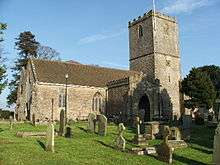
The parish church of St. Mary, also called St Mary Virgin Church,[9] is a Church in Wales parish church. There is evidence that the church has pre-Norman foundations; however, the earliest part of the building dates from the 14th century. It is a Grade I listed building. It is mainly built in the Perpendicular style of the late 14th and 15th centuries.
Education
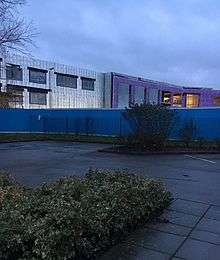
Caldicot School was substantially rebuilt and the new buildings opened in September 2017.[10][11] It will house all subject departments in one single building. The project was part of the Welsh Government's "21st Century Schools & Education Capital Programme". The new building has capacity for 1,500 pupils and was to cost £31million[12] which then rose to £34.9 million. By October 2016, the total cost was said to have risen to £40.175 million.[13]
Governance
Caldicot Town Council comprises seventeen elected or co-opted town councillors, from five community wards, namely Castle, Dewstow, Green Lane, Severn and West End.[14]
Caldicot Castle, Dewstow, Green Lane, Severn and West End are also county wards to Monmouthshire County Council, each electing one county councillor.[15]
Attractions and amenities
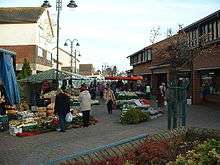
Caldicot is the location of Caldicot Castle and lake. The area has popular waymarked footpaths along the Caldicot Levels and the coastal path can be walked. Nearby are Caerwent and Wentwood. To the north-west, Dewstow House dates from c.1804. Extensive gardens and grottoes built after 1895 have been undergoing restoration since 2000 and are now open to the public.
Five primary schools are located in the area, two of which were created from local Infant and Junior Schools. Durand Primary (with nursery), Ysgol Y Ffin Primary, Castle Park Primary (formed from Sandy Lane Infant School and St Mary's Juniors), Dewstow Primary (formally of West End Infants and Green Lane Juniors) and ARW (Archbishop Rowan Williams Church of Wales Primary School) in Portskewett.
Caldicot is the nearest town to the Welsh side opening of the Severn railway tunnel, although the nearest station serving the line through the tunnel, Severn Tunnel Junction, is at Rogiet, a village which was developed in modern times largely to service the railway.
Caldicot library was built in 1995.
Caldicot Leisure Centre has a sports centre, one of four leisure centres in Monmouthshire. Its facilities include an indoor swimming pool, squash courts and both indoor and outdoor games pitches, and a gym. The Leisure Centre is located next to Caldicot School.[16][17][18] A new astroturf pitch was built before 2013.
In 2014, it was rated one of the most attractive postcode areas to live in Wales.[19]
Twinning
Caldicot is twinned with Waghäusel, Germany and Morières-lès-Avignon France.
Notable people
- See People from Caldicot
References
- "Parish population 2011". Retrieved 3 April 2015.
- https://www.nomisweb.co.uk/reports/localarea?compare=W04000777
- "A Short History of Caldicot". Archived from the original on 22 October 2007. Retrieved 13 January 2008.
- "Origins of the place name". Archived from the original on 9 February 2009. Retrieved 25 September 2008.
- BBC - South East Wales Caldicot - Llanthony Secunda Manor - Ron Lapthorn talks about the history of this distinctive house in Caldicot, Monmouthshire
- A reproduction of the map is at File:Atlas_Ortelius_KB_PPN369376781-011av-011br.jpg
- "A Short History of Caldicot". Archived from the original on 22 October 2007. Retrieved 13 January 2008.
- Some Memorial Inscriptions, Caldicot, Monmouthshire
- "Rectorial Benefice of Caldicot". The Church in Wales. 21 October 2015. Retrieved 8 April 2016.
- "New £36m school opens in Caldicot". BBC News. 11 September 2017. Retrieved 22 October 2017.
- "Caldicot School New Build Update MCC". Monmouthshire. Archived from the original on 7 February 2017. Retrieved 6 February 2017.
- "BBC News article - Monmouthshire to get two new secondary schools by 2016". 17 January 2014.
- "Caldicot School new build cost update".
- "Your Councillors". Caldicot Town Council. Retrieved 6 January 2019.
- The County of Monmouthshire (Electoral Changes) Order 2002. legislation.gov.uk. Statutory Instruments. 6 December 2002. Retrieved 4 January 2019.
- MonLeisure site
- Caldicot Leisure Centre Archived 2011-09-16 at the Wayback Machine
- Leisure Centre information
- "UK's 'most desirable' postcodes revealed". BBC News.